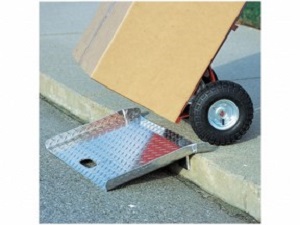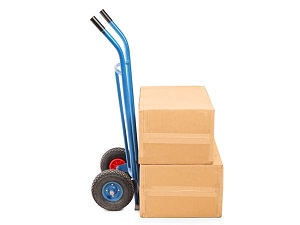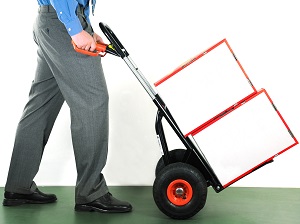Because hand trucks are relatively simple to use, their safety is often taken for granted. While they can reduce the risks associated with manual lifting, there are still safety precautions to consider when hand trucks are used for materials handling.

A hand truck is an L-shaped handcart that has handles at the top and wheels at the base, with a ledge (called a nose plate) that is flat against the floor when it is upright. Hand trucks are used to move stable materials, like boxes, with greater ease than manual lifting and carrying.
The most common dangers associated with hand trucks include:
Caught-in Hazards – fingers and hands get caught in between the hand truck and stationary objects like a wall, corner, barricade or rack
Crushed-by Hazards – toes and feet get crushed by the wheels of the cart or by materials that are dropped or fall off the hand truck
Slips, Trips and Falls – hand trucks that are not loaded properly, are used at a steep angle or on uneven terrain can pose slip and fall risks, while hand trucks not stored safely are a trip hazard for those in the work area
Overexertion – a variety of strain injuries to the back, shoulders and arms are common loading/unloading or even when moving heavily loaded hand trucks
Before using any hand truck, especially if you are the first person on shift to use it, perform a quick inspection before loading materials onto it. A poorly maintained hand truck will greatly increase physical stress on an employee. Check the tire pressure, or overall wheel condition. Check the frame for broken, cracked, or bent sections or other defects or damage. Confirm the load capacity.
OSHA Standard 1910.176(a) Where mechanical handling equipment is used, sufficient safe clearances shall be allowed for aisles, at loading docks, through doorways and wherever turns or passage must be made. Aisles and passageways shall be kept clear and in good repair, with no obstruction across or in aisles that could create a hazard. Permanent aisles and passageways shall be appropriately marked.
Inspect and clear your path before moving any load with a hand truck. Be aware of any potential hazards, including unguarded edges. Ensure there are ramps provided if your path has stairs or curbs. Measure openings to be sure there is sufficient clearance. Corners should accommodate the turning radius of the moving hand truck. Floors should be in good repair, clean and free of clutter and spills. If ramps are not provided, consider using portable curb ramps that eliminate the need to lift and pull fully loaded hand trucks over curbs.

Always use proper lifting technique to prevent back injuries. Keep your back straight while lifting a load. If you must bend down then bend at your knees, not at your waist, and do not twist while lifting a load. Place the load fully on the platform (nose plate) and ensure the load is pushed all the way back to the frame of the hand truck. There shouldn’t be a gap between the load and the frame. Load hand trucks for good balance and stability. When stacking, place the heavier items on the bottom to keep the center of gravity of the load as low as possible.
Keep the materials stacked at or below the top of the hand truck. Unsupported items stacked higher than the handles may slide off once the hand truck is in motion, or the operator will have to use one hand to stabilize which may be unsafe. Never stack items in a way that blocks your view. Always allow for a clear view of the path ahead, especially near docks or any edges without guardrails.
If needed, tie or secure the load to the hand truck to prevent shifting during transport. If using belts or straps to secure the load, always inspect them before use to ensure they are not frayed, worn out or damaged.

When maneuvering a hand truck, always maintain a safe speed and keep the hand truck under control. The hand truck should carry the load while the operator helps keep the load balanced while pushing.
Ensure the load does not block your view and you can clearly see the path you are traveling. Take caution at blind corners and doorways to avoid unexpected collisions with people or equipment. If your visibility is obstructed at any point along your planned route, use a spotter in those areas.
When you lean the hand truck back to begin moving, balance the load over the wheels and axle, so the truck carries the weight. The operator should not be carrying the weight of load with the handles.
Heavier loads can easily overbalance and fall backward if the hand truck leans too far back. Grip the hand truck firmly with two hands. Push with a straight back, leaning into your walk, keeping both hands on the handles. It is safer to push, than to pull. Walk forwards, with the hand truck in front of you, unless you are in a tight space. Avoid walking backwards with a loaded hand truck.
Avoid distractions while operating a hand truck.

When using hand trucks, PPE requirements may vary depending on the location, the type of materials being handled, and facility safety requirements. Wear supportive, closed toe, non-slip shoes. Steel-toed boots may be recommended if you are handling heavier loads. Wearing gloves can provide extra protection from caught-in hazards when maneuvering in tight spaces. Choose gloves that provide a good grip on the handles when pushing the load. If using a hand truck in a high traffic location, like a warehouse or a loading zone, wear a safety vest to provide extra visibility.
When hand trucks are not in use, always place them in a designated area to ensure they will not present any trip and fall hazards. Never leave a hand truck in an aisle, walkway or in any position that is used for pedestrian, heavy equipment or motorist traffic. To avoid creating a tripping hazard, store hand trucks with the nose plate folded up, if that’s possible. If a designated storage area is not available, park hand trucks with the nose plate tucked under a shelf, pallet or table when not in use.

.jpg)

